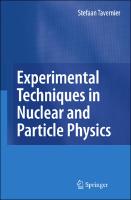Experimental Techniques in Nuclear and Particle Physics
| dc.contributor.author | Tavernier, Stefaan | |
| dc.date.accessioned | 2022-06-20T19:30:43Z | |
| dc.date.available | 2022-06-20T19:30:43Z | |
| dc.date.issued | 2010 | |
| dc.identifier | ONIX_20220620_9783642008290_6 | |
| dc.identifier | ONIX_20220620_9783642008290_6 | |
| dc.identifier | OCN: 630057654 | |
| dc.identifier.uri | https://library.oapen.org/handle/20.500.12657/56972 | |
| dc.description.abstract | I have been teaching courses on experimental techniques in nuclear and particle physics to master students in physics and in engineering for many years. This book grew out of the lecture notes I made for these students. The physics and engineering students have rather different expectations of what such a course should be like. I hope that I have nevertheless managed to write a book that can satisfy the needs of these different target audiences. The lectures themselves, of course, need to be adapted to the needs of each group of students. An engineering student will not qu- tion a statement like “the velocity of the electrons in atoms is ?1% of the velocity of light”, a physics student will. Regarding units, I have written factors h and c explicitly in all equations throughout the book. For physics students it would be preferable to use the convention that is common in physics and omit these constants in the equations, but that would probably be confusing for the engineering students. Physics students tend to be more interested in theoretical physics courses. However, physics is an experimental science and physics students should und- stand how experiments work, and be able to make experiments work. This is an open access book. ; I have been teaching courses on experimental techniques in nuclear and particle physics to master students in physics and in engineering for many years. This book grew out of the lecture notes I made for these students. The physics and engineering students have rather different expectations of what such a course should be like. I hope that I have nevertheless managed to write a book that can satisfy the needs of these different target audiences. The lectures themselves, of course, need to be adapted to the needs of each group of students. An engineering student will not qu- tion a statement like “the velocity of the electrons in atoms is ?1% of the velocity of light”, a physics student will. Regarding units, I have written factors h and c explicitly in all equations throughout the book. For physics students it would be preferable to use the convention that is common in physics and omit these constants in the equations, but that would probably be confusing for the engineering students. Physics students tend to be more interested in theoretical physics courses. However, physics is an experimental science and physics students should und- stand how experiments work, and be able to make experiments work. | |
| dc.language | English | |
| dc.subject.other | Neutron | * |
| dc.subject.other | Particle Physics | * |
| dc.subject.other | Particle accelerator | * |
| dc.subject.other | detector gas ionization | * |
| dc.subject.other | electronics nuclear detector | * |
| dc.subject.other | meassurement technique nuclear | * |
| dc.subject.other | particle acceleration | * |
| dc.subject.other | principle particle accelerator | * |
| dc.subject.other | radiation matter | * |
| dc.subject.other | subatomic poarticles | * |
| dc.subject.other | textbook detector | * |
| dc.subject.other | textbook nuclear experiments | * |
| dc.subject.other | textbook nuclear physics | * |
| dc.subject.other | textbook particle acceleration | * |
| dc.subject.other | textbook particle physics | * |
| dc.subject.other | Textbook | * |
| dc.title | Experimental Techniques in Nuclear and Particle Physics | |
| dc.type | book | |
| oapen.identifier.doi | 10.1007/978-3-642-00829-0 | |
| oapen.relation.isPublishedBy | 6c6992af-b843-4f46-859c-f6e9998e40d5 | |
| oapen.relation.isFundedBy | c2fbf30c-ef0f-473b-8ee4-03e135ae04d0 | * |
| oapen.relation.isbn | 9783642008290 | |
| oapen.collection | SCOAP3 for Books | |
| oapen.imprint | Springer | |
| oapen.pages | 306 | |
| oapen.place.publication | Berlin, Heidelberg |

